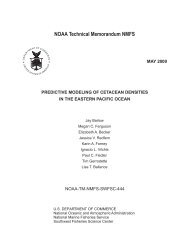NOAA Technical Memorandum NMFS - Southwest Fisheries ...
NOAA Technical Memorandum NMFS - Southwest Fisheries ...
NOAA Technical Memorandum NMFS - Southwest Fisheries ...
You also want an ePaper? Increase the reach of your titles
YUMPU automatically turns print PDFs into web optimized ePapers that Google loves.
pilot whale (n = 4), common bottlenose dolphin (n = 1), and spotted dolphin (n = 1).<br />
Tentative acoustic identifications by an experienced acoustician (S. Rankin) suggest that<br />
false killer whales and rough-toothed dolphins are two species that frequently escape<br />
detection by the visual team. In time, improved acoustic identification of these exclusive<br />
acoustic detections will allow us to examine the species that the visual observation team<br />
often misses during shipboard surveys.<br />
Greater than two-thirds of sighted dolphin schools were detected by the acoustics<br />
team; however, acoustic detection rates varied by species (Table 9). Examination of the<br />
acoustic behavior of these sighted dolphin schools has suggested that dolphin schools<br />
generally can be grouped into two types (Rankin et al. 2008b). The first type is typically<br />
found in larger group sizes in tropical and subtropical waters, is detected at greater<br />
ranges, commonly produce whistles, and is easily detected using the passive acoustics<br />
methods in this study. Examples of species in this group include S. coeruleoalba, S.<br />
longirostris, and S. attenuata. The second type is typically found in smaller group sizes<br />
in temperate waters, is detected at shorter ranges, does not commonly produce whistles,<br />
and is not easily detected using these methods (Rankin et al. 2008b). This second type<br />
includes species such as L. borealis, L. obliquidens, and B. bairdii. These general patterns<br />
have important implications for the use of passive acoustics for population and mitigation<br />
purposes.<br />
There was a strong relationship between group size and vocal activity (detection<br />
of vocalizations) of dolphins. Dolphin schools detected using these acoustic methods<br />
were consistently larger than non-vocal dolphin schools for each species, and for the<br />
combined detections (Table 12). This does not suggest that the vocal rate, or the number<br />
of calls per unit of time, was related to group size. In fact, anecdotal observations<br />
suggest that this is not the case for most species (S. Rankin, pers. comm.). The positive<br />
relationship between the acoustic detection distance and group size is likely influenced by<br />
the large group sizes of whistling dolphins, which can be heard at great distances,<br />
compared to the smaller group size that is characteristic of species that only click, which<br />
have a limited detection range (Fig. 38, Rankin et al. 2008b).<br />
Overall, 23.7% of dolphin schools went undetected by the acoustics. Again, the<br />
acoustic detection rate was not equal for all species. For whistling species (such as<br />
Stenella longirostris, S. attenuata, and Tursiops truncatus), group size had the greatest<br />
effect on acoustic detection rates, with smaller schools most likely being undetected by<br />
the acoustics team (Rankin and Barlow 2005b). The methods presented here were<br />
particularly poor at detecting species that appear primarily (or entirely) to produce clicks<br />
or burst-pulses, such as Lissodelphis borealis (Rankin et al. 2008). In fact, there were no<br />
known acoustic detections of Phocoenidae, Kogiidae, and Ziphiidae using these towed<br />
array methods. There are many reasons to explain the poor detection rates of these<br />
species, including: the narrow beam-pattern of echolocation clicks leads to decreased<br />
detection range, the peak frequencies and bandwidth of many of these click sounds are<br />
above the frequency response range of our system (e.g. frequencies are too high), and<br />
high-frequency clicks have greater transmission loss so are detected at shorter ranges than<br />
whistles.<br />
In summary, we have found a strong relationship between group size and vocal<br />
behavior. Also, dolphin schools that primarily produce clicks are found in smaller group<br />
sizes than dolphins that produce whistles (Rankin et al. 2008, Oswald et al. in press).<br />
15









